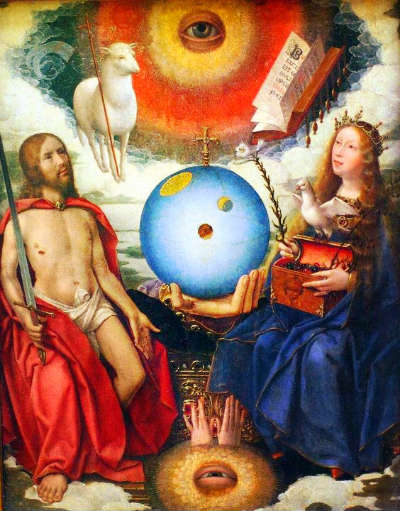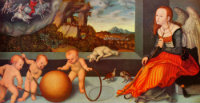Search:: Artists Alphabetically Artists by Country Artists by Century Artists by Movement
Signs and Symbols in Biblically Themed painting
The Meaning of Sacred Symbols in Christian themed Byzantine, Gothic and Renaissance Painting
An open book, a bowel of strawberries, a sleeping dog, a key in a lock, a mirror, a raven—all are charmingly decorative to the average viewer. For painters of the Gothic, Renaissance and Northern Renaissance eras, symbols were part of a rich visuallanguage. In a culture of restricted literacy, symbolic imagery was crucial in keeping sinners on the path to heaven. Narrative paintings, with their layer upon layer of vivid symbolism, provided instruction to the uneducated peasants who craved scriptural guidance. Paintings throughout Western history have been used as guides in illuminating the divine mysteries of Gods Holy Word.

Allegory of Christianity c.1515 by Jan Provoost
Byzantine, Gothic and Early Renaissance Art are rich in philosophical and Christian symbolism. Narrative paintings, with their layer upon layers of symbolism, provided instruction to the uneducated commoners who hungered for biblical knowledge. Paintings were used as guides in revealing the divine mysteries of the Christian faith. Eminent art historian and aurthor, Clive Bell explains "The earliest Christian paintings in the catacombs are purely classical. If the early Christians felt anything new they could not express it. But before the second century was out Coptic craftsmen had begun to weave into dead Roman designs something vital. The academic patterns are queerly distorted and flattened out into forms of a certain significance, as we can feel for ourselves if we go to the textile room at South Kensington. Certainly, these second century Coptic textiles are more like works of art than anything that had been produced in the Roman Empire for more than four hundred years. Egyptian paintings of the third century bear less positive witness to the fumblings of a new spirit. But at the beginning of the fourth century Diocletian built his palace at Spalato, where we have all learned to see classicism and the new spirit from the East fighting it out side by side; and, if we may trust Strzygowski, from the end of that century dates the beautiful church of Kodja-Kalessi in Isauria. The century in which the East finally dominated the West (350-450) is a period of incubation. It is a time of disconcerting activity that precedes the unmistakable launch of art upon the Christian slope. "
Symbolism and iconography are central to the reading of works of art within the Western Christian tradition. The creative use of symbols adds a certain glory and holiness to Biblically inspired painting, speaking as it does of a hidden world and a mystical faith.
Many early Christians were regarded by both the common people and the Romans as being dangerous radicals. The excessively puritanical Christian lifestyle was in direct conflict with the decadent pagan world. Christianity, because of its monotheistic faith, refused to offer the expected sacrifices and veneration to other heathen gods. Many Christian customs were misunderstood, such as the sacramental rite (wine symbolizing drinking the blood and bread - symbolizing eating the flesh) of Christ and were alleged to be an act of cannibalism. This brought down upon the believers the wrath and persecution of vengeful Romans. During this age of intolerance Christian art made use of symbols as a way conveying their beliefs and as reminders of the spiritual world.
The Meaning of Sacred Symbols in Paintings. Most prominently featured symbols and their meaning:
The Four Evangelists
If you feel you have worthwhile information you would like to contribute we would love to hear from you. We collect essential biographical information and artist quotes from folks all over the globe and appreciate your participation. When submitting please, if possible, site the source and provide English translation. Email to millardmulch@gmail.com
☼☼☼☼☼
Key Words, People and Principal Phrases, Characteristics Related to the Northern Renaissance Art Movement - allegorical painting, rebirth, invention of oil painting, Hieronymus Bosch, Limbourg Brothers, Desiderius Erasmus, Robert Campin, Jan Van Eyck, Jean Fouquet, Albrecht Dürer, Johannes Gutenberg, Johann Reuchlin, Martin Luther, rise of the merchant class, world landscape, Low Countries, Protestant Reformation, Calvinisim, glazing, impasto, scriptorium, illuminator, invention of the printing press, woodcuts, engravings, Antwerp School, Guild of Saint Luke, commerce, Flemish School, Northern Europe, Antwerp School, Flanders, Bruges, renewed interest in classical learning, mythological scenes, genre painting, landscapes, portraits, moralizing overtones, human vices, lust, paradise, spirituality, piousness, living a simple life, reform, Human Reasoning, tradesmen at work, idyllic scenes of peasants, playing games, feasting, linear perspective, \Heliocentric Theory, humour, satire, spiritually significant, illuminated manuscript, idealized biblical themes, scriptorium, emotion, illuminator, iconoclast, Age of Discovery, Virgin and Child, axonometric drawing, curiosity about the natural world, realistic use of colours and light, Old Testament stories, Gospel parables, The Blackdeath, Christian symbolism
Require more facts and information about The iconographical interpretation of Symbols in Byzantine, Gothic and Renaissance Painting? Poke around every nook and cranny of the known universe for information this subject. Search Here
© HistoryofPainters.com 2017
If you like this page and wish to share it, you are welcome to link to it, with our thanks.

